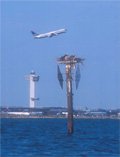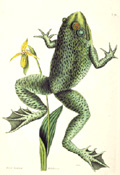|
New York City’s 578 diverse miles of shoreline
include beaches, rocky banks, salt marshes, and landfill waterfront.
There are also uninhabited islets in the harbors and rivers
and, inland, freshwater marshes, streams, lakes, and man-made
reservoirs and ponds. This section is devoted to the waterfowl,
shorebirds, amphibians, turtles, and shore crabs who inhabit
these shores and wetlands.
The Federal Clean Water Act of 1972 initiated
a turnaround from a dismal past of increasingly polluted waters.
In the years since its passage, improving habitats have supported
growing populations of wetland wildlife, including threatened
and endangered species. The year 1972 also saw the creation
of Gateway National Recreation Area, under the stewardship
of the National Park Service, which incorporated various important
natural shorelands, mostly within city boundaries: the Jamaica
Bay and Breezy Point complexes and other land in the Rockaways,
and parklands on eastern Staten Island.
A consortium of international conservation groups
has designated Jamaica Bay Wildlife Refuge, together with
six other sites in the city, as an Important Bird Area (IBA).
Other wetland IBAs within the city are North and South Brother
Islands in the East River, part of the Harbor Herons Complex,
which includes three islands off northwestern Staten Island,
together with adjacent wetlands. All furnish roosting and
nesting sites for expanding populations of water birds, such
as herons, egrets, ibises, and cormorants. In addition, Jamaica
Bay Wildlife Refuge is a rest stop for migrants and a seasonal
home to such species as Snow Geese, who winter at the Refuge
in huge flocks.
All the news is not upbeat, however. Jamaica
Bay marsh grasses, vital to the health of the complex ecosystem,
have been dying for some years, causing the mudflats to wash
away. Experts foresee the disappearance of these marshlands
within twenty years if this erosion is not halted.
Check out the sighting
log to record your interaction with some of the native
New York City wildlife featured in Urban Neighbors.
You may also browse the sighting log by animal, borough, park
or natural area, and/or habitat to view a sighting you have
submitted or to read others’ observations.
|
1

Wood Duck / NYPL
2

American Bittern /
NYPL
3

Osprey / Don Riepe, National
Park Service
4

Diamondback Terrapin / NYPL
5

Bullfrog / NYPL
|






